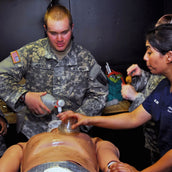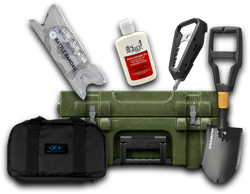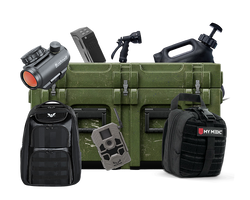
Surviving in the Mountains
Mountains make for beautiful hiking and camping locations, but they can also be deadly for the unprepared explorer. Whether it’s a hike gone wrong or the rare plane crash over the mountains, stories abound of both success and failure in overcoming brutal mountain conditions, the harshest of which occur in the winter. While summer in the mountains is similar to surviving in a forest, fall/winter in the mountains is a unique beast because of all the bad weather potentials. With proper preparation, any survivalist can improve their likelihood of thriving in a SHTF situation in the mountains. The following are vital tips to understand prior to any expedition in a snowy, mountainous environment:
Inventory Your Gear. If you are hiking in the mountains, we will assume you have the proper gear with you – boots, cold-weather clothing, crampons or snowshoes, ice axe, insulated sleeping bag, duct tape, etc. However, if you find yourself without the appropriate gear, you will need to get creative quickly to ensure mountain survival. You can use sturdy sticks and paracord, fishing line, or shoelaces to construct makeshift snowshoes. This will be essential if you are traversing deep, soft snow. Also bring gear that may help you find food. You will also have to construct a shelter. If you have a tool to dig with, you can dig out a snow cave. If not, seek out an area somewhat protected from the elements such as a cave or trench. If the snow is shallow enough, dig to the ground then build up snow walls and cover the opening with brush to trap your body heat inside the shelter. Another great piece of gear to have is a GPS with satellite imagery, so that you can have a very clear look at the terrain.
Stay Warm. Hypothermia and dehydration are major dangers in cold, mountainous areas. Remove clothing layers while you trek before you start sweating, as you lose heat much faster when your skin is moist. Conversely, if temperatures are below freezing, ensure there are no gaps between your articles of clothing where your skin can be exposed to the cold and the wind. Cover your head and face with a hat and scarf. Night is the most dangerous time, as you will not be exercising to produce body heat and the temperatures will drop the lowest. If you can do so safely, build a fire to produce heat and boil water. Fill water bottles with hot water and keep them in your sleeping bag/shelter at night to stay warm.
Avoid Avalanches. Avalanches are the greatest danger in a mountain survival situation. Only one in five people with avalanche training survive when caught in an avalanche. There are four different kinds of avalanches to be aware of: slab - a plate of snow breaks of a mountain and starts sliding down in one large piece, hard slab - hard-packed snow breaks off and hurtles downward often breaking into several large pieces, soft slab - a slab avalanche where the snow breaks up more readily as it falls down the mountain, and loose snow - triggered by a small amount of moving snow that accumulates into a big slide. Avalanches are most common on long, wide-open 30-45 degree slopes with few trees. They can also be triggered by solar radiation, so avoid areas where the sun is beating down and slush could come loose. Always traverse in switchbacks when trekking down a mountain to limit the likelihood of triggering an avalanche. If an avalanche does occur, then ensure that you have some idea of how to make a snow shelter for deep snow scenarios. Also have an avalanche beacon, or light, so that you can find your way out.
Avoid Glaciers. Glaciers are another dangerous terrain to trek across. Glaciers often have hidden crevasses that can be hundreds of feet deep and impossible to escape. There is also the danger of a falling rock of ice hindering your trek or even your survival. Only trek across glaciers if it is absolutely necessary and if so, test areas carefully before each step.
Be Cautious of Altitude Sickness. Typically, your best plan of action would likely be to travel down in an attempt to reach villages at the base of the mountain. However, if you are in a situation where your best chance of a rescue party finding you is to continue ascending, whether to reach an inhabited area that you know exists, or to get a better view of your surroundings, you must be cautious about altitude sickness. Rapid ascent to a higher elevation can lead to altitude sickness. Symptoms include: dizziness, fatigue, headache, loss of appetite, nausea, vomiting, rapid pulse, and shortness of breath among others. A severe case can lead to death, so it is important to descend quickly and immediately if you believe you are experiencing altitude sickness.
Depending on your location, know these 6 trees for survival.
The mountains are some of the most awe-inspiring views on Earth. Hiking and camping in the mountains in winter can be an amazing experience if you have the training to do so safely. Survival experts will tell you that having good physical fitness and gear are not the only things you need to survive in the mountains. You also need to keep your wits about you to get out on the other end of your adventure safe. When planning an expedition, it is always important to be well-prepared for possible emergency situations and to have the proper gear with you to give yourself the best chance of survival.
Share this article







